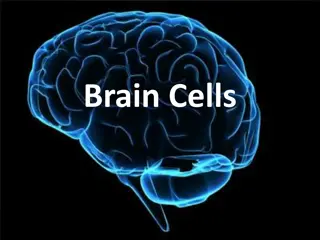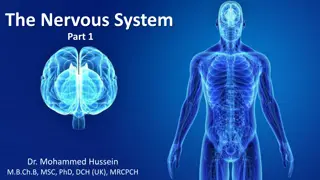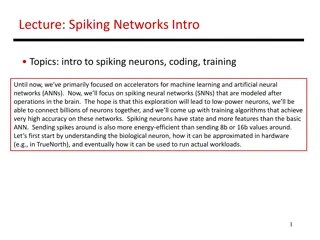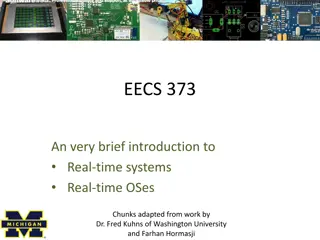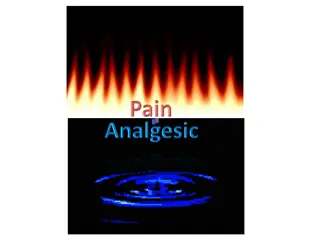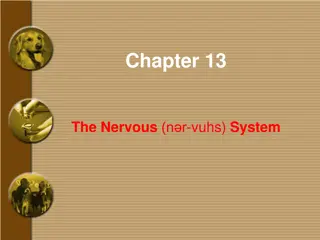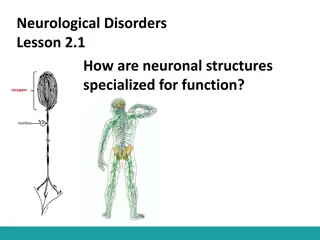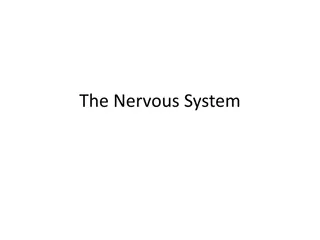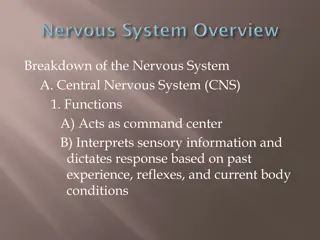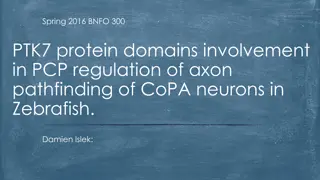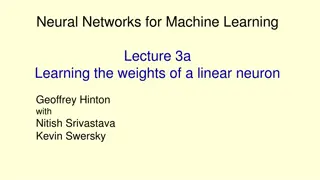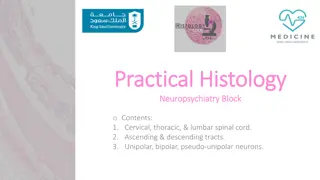Real neurons
Neurons are essential components of the nervous system, responsible for transmitting signals through specialized structures like dendrites, axons, and axon terminals. They communicate through electrical and chemical processes, involving action potentials and synaptic transmission across the synapse. Explore the intricate details of neuron anatomy and the fascinating mechanisms behind neuron communication.
Download Presentation

Please find below an Image/Link to download the presentation.
The content on the website is provided AS IS for your information and personal use only. It may not be sold, licensed, or shared on other websites without obtaining consent from the author.If you encounter any issues during the download, it is possible that the publisher has removed the file from their server.
You are allowed to download the files provided on this website for personal or commercial use, subject to the condition that they are used lawfully. All files are the property of their respective owners.
The content on the website is provided AS IS for your information and personal use only. It may not be sold, licensed, or shared on other websites without obtaining consent from the author.
E N D
Presentation Transcript
Real neurons CS786 29thJanuary 2021
4 parts of the neuron Dendrites are specialized to receive signals from neighboring neurons and carry them back to the cell body 1. Thin, bushy-like structures that receive information from outside the neuron Relays the information into the cell body
The Neuron 2. The Cell body contains the cell nucleus The cell body relays the information down to the axon
The structure of a neuron 3. Axon: A thin, long structure that transmits signals from the cell body to the axon terminal. 4. Axon Terminal is the last step for the relay of information inside the neuron.
The cell body is covered with Axon Terminals
Once the information hits the terminal, it is transmitted outside the cell by neurotransmitters, which reside in the axon terminal.
How do Neurons Communicate? -Electrical Communication -Chemical Communication
The Electrical Part Action potential is an electrical current sent down the axon. The activity within the neurons is electrical. This current causes the neuron to fire This is an all-or-none process
Synaptic transmission The Synapse is the space between neurons The synaptic gap or cleft Information must be transmitted across the synapse to other neurons via the neurotransmitters. This is an electrochemical process
The perception-action circuit sensory neuron interneuron sensory receptors effector motor neuron
A Simple Nerve Circuit the Reflex Arc. A reflex is an autonomic response.
Neuron electrochemistry At rest, the neuron has a higher concentration of K than Na Channels Na channels are quick- responding K channels are slow-responding Impulse from neurotransmitters opens ion channels locally in neuron Na rushes into neuron cell body quickly K takes time, because channels are slower
Three Steps for firing Resting potential: voltage is about -70mV Dendrites receive incoming signals If sufficient, cell goes into firing mode Action potential Voltage changes from -70mV to +40mV Ions exchange places Repeats itself rapidly down axon Only in places where myelin sheath doesn t cover: Nodes of Ranvier Refractory Period: below resting or lower than -70mV Cell recovers from firing Absolute refractor period: Brief time period when cannot fire again Relative refractory period: Brief time period when difficult for it to fire again.
The Neuron Fires Action potential causes nearby Na+ channels to open, so another action potential is triggered right next to first one, and this continues all the way down the axon Chain reaction Like a bunch of dominoes Action potential local potential in several important ways: Local potential = graded potential- it varies in magnitude depending on strength of stimulus that produced it; action potential is ungraded Action potential obeys all or none law: occurs at full strength or not at all Action potential is nondecremental: does NOT lose strength at each successive point (local potentials do degrade)
The Neurotransmitter Neurotransmitter is chemical Several specific kinds- each act on certain neurons Most neurons respond to and release one kind of neurotransmitter Neurotransmitter stored in synaptic vesicles The synaptic vesicles move to and fuse to end of membrane Action potential opens channels that allow Ca+ ions to enter terminals from extracellular fluid Ca+ ions cause vesicles nearest the membrane to fuse with membrane Membrane then opens and transmitter is dumped into synapse Diffuses across synapse to postsynaptic neuron and attaches to chemical receptor
Action in the Synapse Neurotransmitter is released into the synapse diffuses across synapse to next neuron s dendrite This next dendrite is post-synaptic Neurotransmitter is attracted to the POST-synaptic side: receptor sites on the next neurons dendrites neurotransmitter must match molecular shape of receptor site Activation of receptor causes ion channels in membrane to open
Two kinds of Receptor Action Ionotropic receptors open channels directly to produce immediate reactions required for motor and sensory processing Metabotropic receptors open channels indirectly slower: but produce longer-lasting effects Sets off graded potentials for next action potential Movement across the synapse is relatively slow: several milliseconds
Excitation and Inhibition The NT opens ion channels on dendrites and soma Two effects on local membrane potential: shifts in positive direction (towards 0), partially depolarizing Shifts in negative direction (away from 0): hyperpolarization Thus two effects: Excitatory: depolarization (moves toward and past 0) Inhibitory: hyperpolarization (moves away from 0)
Two kinds of postsynaptic potentials: EPSPs: excitatory postsynaptic potentials Excitatory effect: increases likelihood of action potential Opens Na+ channels IPSPs: inhibitory postsynaptic potentials Inhibitory effect: decreases likelihood of action potential Opens K+ channels Thus: bidirectional effects Summative effects Overall change must be sufficient to produce action potential
Postsynaptic integration Summation across all the IPSPs and EPSPs Summates algebraically Adds both positive and negatives together Two kinds: Spatial summation: Sum of all IPSPs and EPSPs occurring simultaneously at different locations along dendrites and cell body Must be sufficient number of hits Temporal summation Sum of all IPSPs and EPSPs occurring within a short time Must occur within a few milliseconds Must get sufficient number of hits within certain time Neuron is an information integrator! A decision maker Small microprocessor
Temporal dynamics of synaptic response Spike-timing dependent plasticity has been experimentally documented




